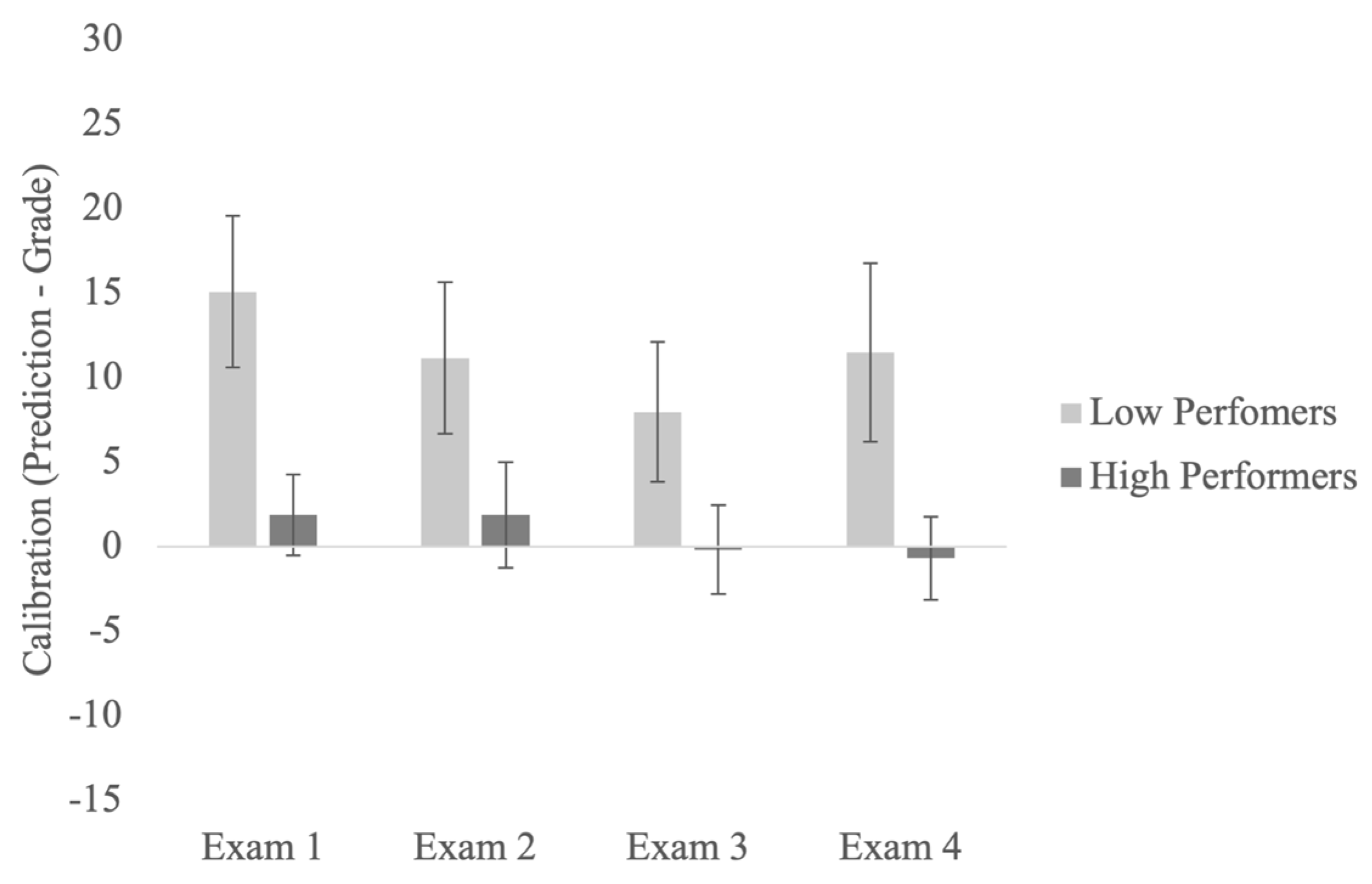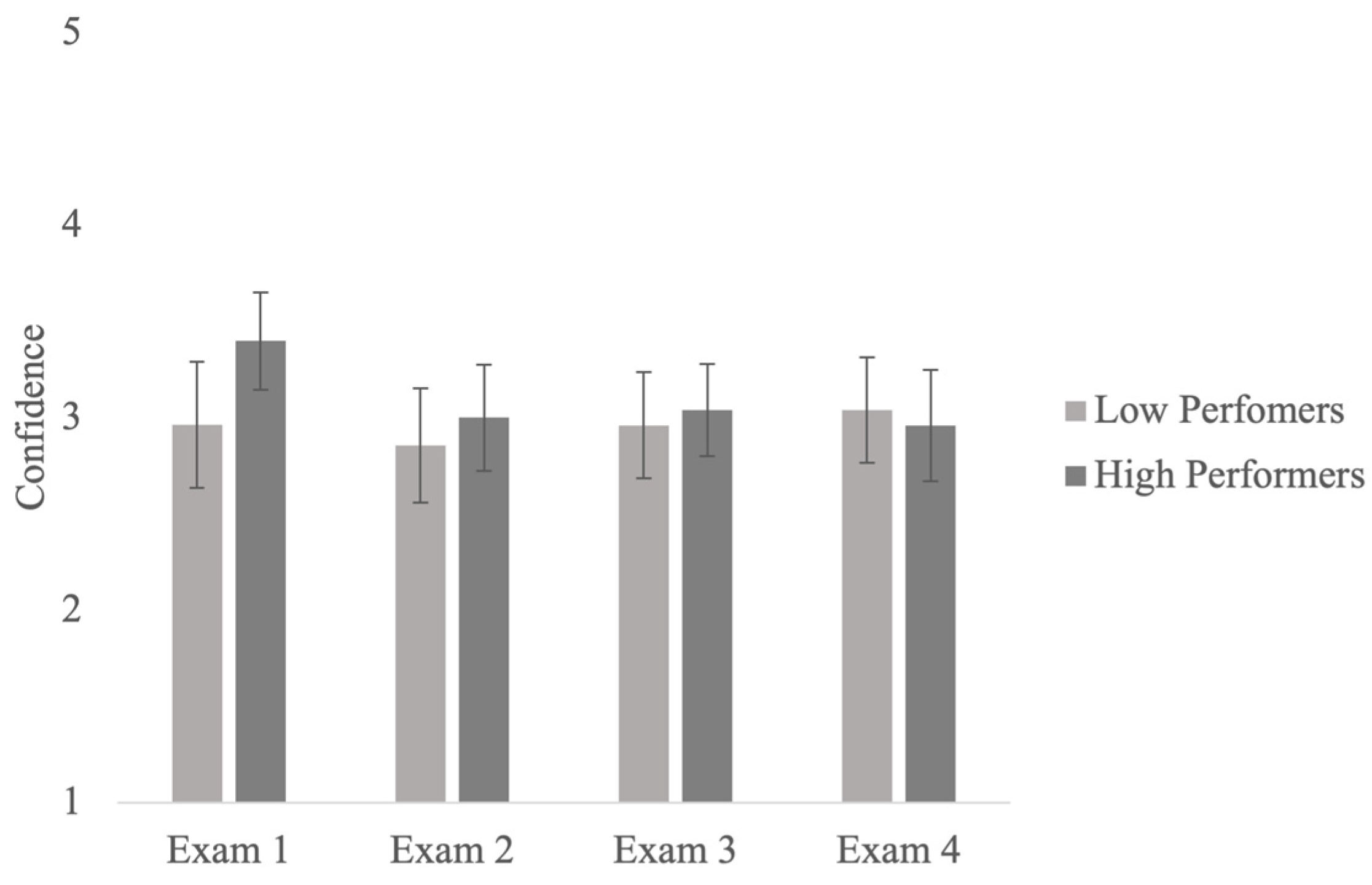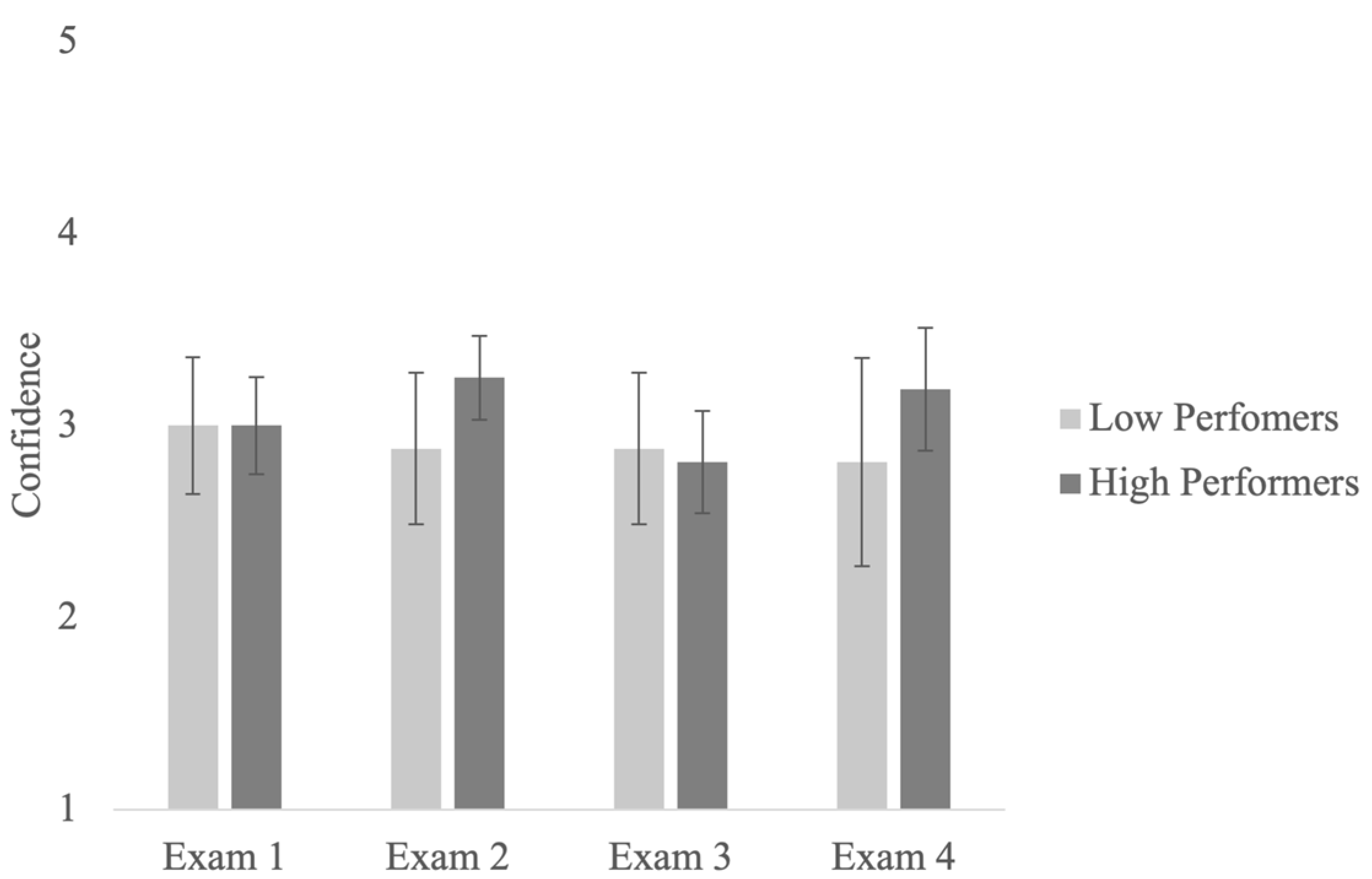Low-Performing Students Confidently Overpredict Their Grade Performance throughout the Semester
Abstract
:1. Introduction
2. Study 1
2.1. Method
2.1.1. Participants
2.1.2. Design and Procedure
2.2. Results
2.2.1. Calibration and Confidence by Performance Level
2.2.2. Calibration across Tests
2.2.3. Second-Order Judgments
3. Study 2
3.1. Method
3.1.1. Participants
3.1.2. Design and Procedure
3.2. Results
3.2.1. Calibration and Confidence by Performance Level
3.2.2. Calibration across Tests
3.2.3. Second Order Judgments
3.2.4. Relationships across Tests
4. General Discussion
Author Contributions
Funding
Institutional Review Board Statement
Informed Consent Statement
Data Availability Statement
Conflicts of Interest
| 1 | For Exams 2 and 3, three students selected two options while making a judgment related to their confidence. Their first choice was included in the analysis. |
| 2 | We pooled the data from both studies and performed the same analysis using the absolute calibration scores. The main finding showing differences between low- and high-performing students remained. |
References
- Bol, Linda, and Douglas J. Hacker. 2001. A comparison of the effects of practice tests and traditional review on performance and calibration. Journal of Experimental Education 69: 133–52. [Google Scholar] [CrossRef]
- Bol, Linda, Douglas J. Hacker, Camilla Walck, and John Nunnery. 2012. The effects of individual or group guidelines on the calibration accuracy and achievement of high school biology students. Contemporary Educational Psychology 37: 280–87. [Google Scholar] [CrossRef]
- Buratti, Sandra, Carl Martin Allwood, and Sabina Kleitman. 2013. First- and second-order metacognitive judgments of semantic memory reports: The influence of personality traits and cognitive styles. Metacognition Learning 8: 79–102. [Google Scholar] [CrossRef]
- Butler, Deborah. L., and Philip H. Winne. 1995. Feedback and self-regulated learning: A theoretical synthesis. Review of Educational Research 65: 245–81. [Google Scholar] [CrossRef]
- Dunlosky, John, Katherine A. Rawson, Elizabeth J. Marsh, Mitchell J. Nathan, and Daniel T. Willingham. 2013. Improving students’ learning with effective learning techniques: Promising directions from cognitive and educational psychology. Psychological Science in the Public Interest 14: 4–58. [Google Scholar] [CrossRef]
- Dunlosky, John, Michael Serra, Greg Matvey, and Katherine Rawson. 2005. Second-order judgments about judgments of learning. Journal of General Psychology 132: 335–46. [Google Scholar] [CrossRef]
- Everson, Howard T., and Sigmund Tobias. 1998. The ability to estimate knowledge and performance in college: A metacognitive analysis. Instructional Science 26: 65–79. [Google Scholar] [CrossRef]
- Ferrari, Michel D., and Robert J. Sternberg. 1998. Self-Awareness: Its Nature and Development. New York: Guilford Press. [Google Scholar]
- Foster, Nathaneil L., Christopher A. Was, John Dunlosky, and Randall M. Isaacson. 2017. Even after thirteen class exams, students are still overconfident: The role of memory for past exam performance in student predictions. Metacognition and Learning 12: 1–19. [Google Scholar] [CrossRef]
- Fritzsche, Eva S., Marion Händel, and Stephan Kröner. 2018. What do second-order judgments tell us about low-performing students’ metacognitive awareness? Metacognition and Learning 13: 159–77. [Google Scholar] [CrossRef]
- Gramzow, Richard H., Andrew J. Elliot, Evan Asher, and Holly A. McGregor. 2003. Self-evaluation bias and academic performance: Some ways and some reasons why. Journal of Research in Personality 37: 41–61. [Google Scholar] [CrossRef]
- Hacker, Douglas J., Linda Bol, and Kamilla Bahbahani. 2008. Explaining calibration accuracy in classroom contexts: The effects of incentives, reflection, and explanatory style. Metacognition and Learning 3: 101–21. [Google Scholar] [CrossRef]
- Hacker, Douglas J., Linda Bol, Dianne D. Horgan, and Ernest A. Rakow. 2000. Test prediction and performance in a classroom context. Journal of Educational Psychology 92: 160–70. [Google Scholar] [CrossRef]
- Händel, Marion, and Eva S. Fritzsche. 2013. Students’ confidence in their performance judgements: A comparison of different response scales. Educational Psychology 35: 377–95. [Google Scholar] [CrossRef]
- Händel, Marion, and Eva. S. Fritzsche. 2016. Unskilled but subjectively aware: Metacognitive monitoring ability and respective awareness in low-performing students. Memory and Cognition 44: 229–41. [Google Scholar] [CrossRef] [PubMed]
- Kramarski, Bracha, and Vered Dudai. 2009. Group metacognitive support for online inquiry in mathematics with differential self-questioning. Journal of Educational Computing Research 40: 377–404. [Google Scholar] [CrossRef]
- Krueger, Joachim, and Ross A. Mueller. 2002. Unskilled, unaware, or both? The better-than-average heuristic and statistical regression predict errors in estimates of own performance. Journal of Personality and Social Psychology 82: 180–88. [Google Scholar] [CrossRef]
- Kruger, Justin, and David Dunning. 1999. Unskilled and unaware of it: How difficulties in recognizing one’s own incompetence lead to inflated self-assessments. Journal of Personality and Social Psychology 77: 1121–34. [Google Scholar] [CrossRef]
- Maki, Ruth H., and Sharon L. Berry. 1984. Metacomprehension of text material. Journal of Experimental Psychology: Learning, Memory, and Cognition 10: 663–79. [Google Scholar] [CrossRef]
- Miller, Tyler M., and Lisa Geraci. 2011a. Training metacognition in the classroom: The influence of incentives and feedback on exam predictions. Metacognition and Learning 6: 303–14. [Google Scholar] [CrossRef]
- Miller, Tyler M., and Lisa Geraci. 2011b. Unskilled but Aware: Reinterpreting Overconfidence in Low-Performing Students. Journal of Experimental Psychology: Learning, Memory, and Cognition 37: 502–6. [Google Scholar] [CrossRef]
- Morphew, Jason W. 2021. Changes in metacognitive monitoring accuracy in an introductory physics course. Metacognition and Learning 16 89–111. [Google Scholar] [CrossRef]
- Nederhand, Marloes L., Huib K. Tabbers, Anique B. H. De Bruin, and Remy M. J. P. Rikers. 2021. Metacognitive awareness as measured by second-order judgements among university and secondary school students. Metacognition and Learning 16: 1–14. [Google Scholar] [CrossRef]
- Saenz, Gabriel D., Lisa Geraci, and Robert Tirso. 2019. Improving metacognition: A comparison of interventions. Applied Cognitive Psychology 33: 918–29. [Google Scholar] [CrossRef]
- Serra, Michael J., and Kenneth G. DeMarree. 2016. Unskilled and unaware in the classroom: College students’ desired grades predict their biased grade predictions. Memory & Cognition 44: 1127–37. [Google Scholar] [CrossRef]
- Sternberg, R. J. 1990. Metaphors of Mind: Conceptions of the Nature of Intelligence. Cambridge; New York: Cambridge University Press. [Google Scholar]
- Thiede, Keith W., Mary C. M. Anderson, and David Therriault. 2003. Accuracy of metacognitive monitoring affects learning of texts. Journal of Educational Psychology 95: 66–73. [Google Scholar] [CrossRef]
- Tirso, Robert, Lisa Geraci, and G. D. Saenz. 2019. Examining underconfidence among high-performing students: A test of the false consensus hypothesis. Journal of Applied Research in Memory and Cognition 8: 154–65. [Google Scholar] [CrossRef]
- Washburn, David A., J. David Smith, and Lauren A. Taglialatela. 2005. Individual differences in Metacognitive responsiveness: Cognitive and personality correlates. The Journal of General Psychology 132: 446–61. [Google Scholar] [CrossRef]




| Points | Grade |
|---|---|
| 92.50–100.00 | A |
| 89.50–92.49 | A− |
| 86.50–89.49 | B+ |
| 82.50–86.49 | B |
| 79.50–82.49 | B− |
| 76.50–79.49 | C+ |
| 72.50–76.49 | C |
| 69.50–72.49 | C− |
| 66.50–69.49 | D+ |
| 59.50–66.49 | D |
| 00.00–59.49 | F |
| Quartile | Prediction | Grade | Calibration | Confidence |
|---|---|---|---|---|
| Exam 1 | ||||
| 1 (n = 28) | 84.01 (8.29) | 68.93 (8.22) | 15.08 (12.12) | 2.96 (0.88) |
| 2 (n = 31) | 87.45 (5.33) | 74.52 (5.55) | 12.93 (8.31) | 3.10 (0.66) |
| 3 (n = 26) | 89.96 (6.29) | 82.95 (7.44) | 7.01 (9.51) | 3.35 (0.75) |
| 4 (n = 25) | 91.61 (4.66) | 89.74 (4.90) | 1.87 (6.12) | 3.40 (0.65) |
| Exam 2 | ||||
| 1 | 82.95 (7.40) | 71.79 (9.14) | 11.16 (12.14) | 2.86 (0.80) |
| 2 | 85.29 (7.35) | 78.61 (7.59) | 6.69 (8.96) | 2.77 (0.76) |
| 3 | 88.64 (8.12) | 84.36 (6.78) | 4.28 (10.87) | 3.27 (0.78) |
| 4 | 91.36 (4.35) | 89.47 (5.83) | 1.88 (7.96) | 3.00 (0.71) |
| Exam 3 | ||||
| 1 | 83.68 (7.80) | 75.72 (8.55) | 7.97 (11.17) | 2.96 (0.74) |
| 2 | 85.75 (6.49) | 83.01 (7.86) | 2.74 (9.50) | 2.74 (0.51) |
| 3 | 88.29 (5.13) | 85.26 (6.20) | 3.03 (8.09) | 3.50 (0.51) |
| 4 | 91.70 (5.34) | 91.87 (4.42) | −0.18 (6.70) | 3.04 (0.61) |
| Exam 4 | ||||
| 1 | 81.84 (6.32) | 70.36 (12.71) | 11.48 (14.22) | 3.04 (0.74) |
| 2 | 85.91 (6.94) | 81.72 (5.30) | 4.19 (7.64) | 2.87 (0.67) |
| 3 | 87.89 (5.73) | 86.54 (6.00) | 1.35 (7.20) | 3.54 (0.65) |
| 4 | 90.93 (5.15) | 91.60 (4.42) | −0.68 (6.61) | 2.96 (0.74) |
| Quartile | Prediction | Grade | Calibration | Confidence |
|---|---|---|---|---|
| Exam 1 | ||||
| 1 (n = 16) | 86.52 (6.55) | 65.41 (8.06) | 21.10 (9.45) | 3.00 (0.73) |
| 2 (n = 17) | 87.75 (5.72) | 70.59 (7.19) | 17.16 (8.76) | 2.65 (0.70) |
| 3 (n = 17) | 86.71 (5.13) | 76.08 (10.15) | 10.63 (13.59) | 3.00 (0.71) |
| 4 (n = 16) | 88.00 (5.32) | 83.33 (9.11) | 4.67 (11.18) | 3.00 (0.52) |
| Exam 2 | ||||
| 1 | 83.69 (8.31) | 60.83 (8.82) | 22.86 (9.07) | 2.88 (0.81) |
| 2 | 84.37 (7.14) | 72.35 (11.35) | 12.02 (9.49) | 3.18 (0.64) |
| 3 | 85.35 (5.23) | 79.41 (6.04) | 5.94 (6.42) | 3.00 (0.79) |
| 4 | 87.08 (5.69) | 87.50 (5.77) | −0.42 (6.42) | 3.25 (0.45) |
| Exam 3 | ||||
| 1 | 82.23 (8.75) | 63.54 (10.22) | 18.70 (11.47) | 2.88 (0.81) |
| 2 | 79.12 (9.11) | 76.27 (6.96) | 2.85 (11.57) | 3.00 (1.23) |
| 3 | 84.01 (5.55) | 77.06 (8.07) | 6.96 (10.61) | 3.06 (0.90) |
| 4 | 87.05 (5.40) | 87.91 (8.42) | −0.87 (8.29) | 2.81 (0.54) |
| Exam 4 | ||||
| 1 | 79.23 (15.22) | 66.04 (9.98) | 13.19 (16.34) | 2.81 (1.11) |
| 2 | 79.97 (7.30) | 70.59 (10.49) | 9.38 (14.33) | 3.06 (0.90) |
| 3 | 83.74 (7.23) | 82.16 (8.16) | 1.58 (6.96) | 3.00 (1.00) |
| 4 | 88.17 (3.55) | 91.25 (7.97) | −3.08 (7.89) | 3.19 (0.66) |
Disclaimer/Publisher’s Note: The statements, opinions and data contained in all publications are solely those of the individual author(s) and contributor(s) and not of MDPI and/or the editor(s). MDPI and/or the editor(s) disclaim responsibility for any injury to people or property resulting from any ideas, methods, instructions or products referred to in the content. |
© 2023 by the authors. Licensee MDPI, Basel, Switzerland. This article is an open access article distributed under the terms and conditions of the Creative Commons Attribution (CC BY) license (https://creativecommons.org/licenses/by/4.0/).
Share and Cite
Karaca, M.; Geraci, L.; Kurpad, N.; Lithander, M.P.G.; Balsis, S. Low-Performing Students Confidently Overpredict Their Grade Performance throughout the Semester. J. Intell. 2023, 11, 188. https://doi.org/10.3390/jintelligence11100188
Karaca M, Geraci L, Kurpad N, Lithander MPG, Balsis S. Low-Performing Students Confidently Overpredict Their Grade Performance throughout the Semester. Journal of Intelligence. 2023; 11(10):188. https://doi.org/10.3390/jintelligence11100188
Chicago/Turabian StyleKaraca, Meltem, Lisa Geraci, Nayantara Kurpad, Marcus P. G. Lithander, and Steve Balsis. 2023. "Low-Performing Students Confidently Overpredict Their Grade Performance throughout the Semester" Journal of Intelligence 11, no. 10: 188. https://doi.org/10.3390/jintelligence11100188
APA StyleKaraca, M., Geraci, L., Kurpad, N., Lithander, M. P. G., & Balsis, S. (2023). Low-Performing Students Confidently Overpredict Their Grade Performance throughout the Semester. Journal of Intelligence, 11(10), 188. https://doi.org/10.3390/jintelligence11100188





